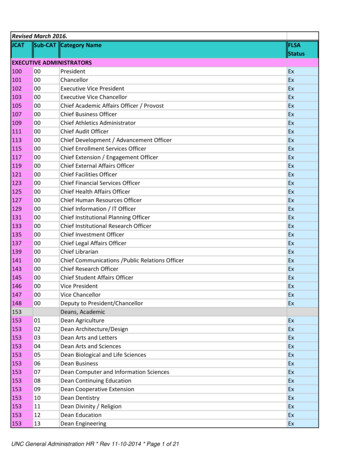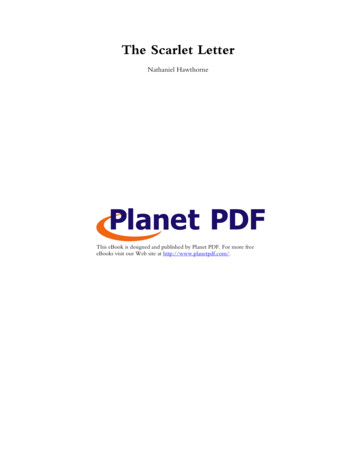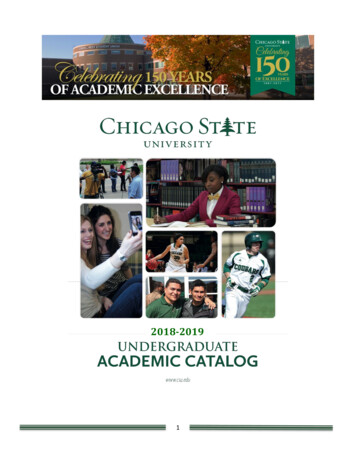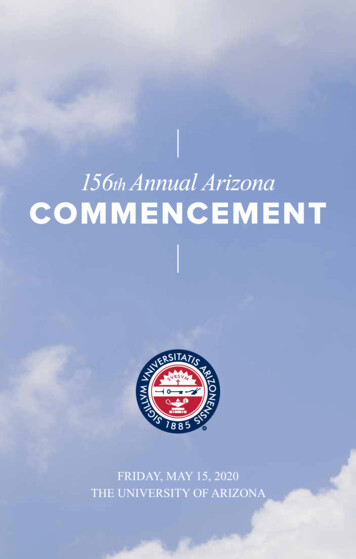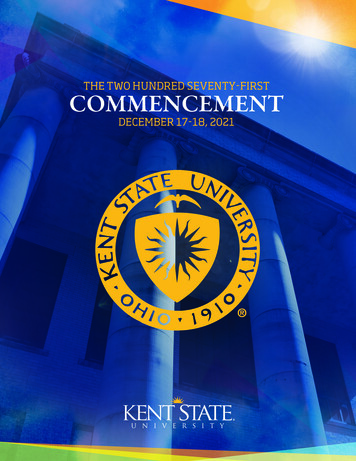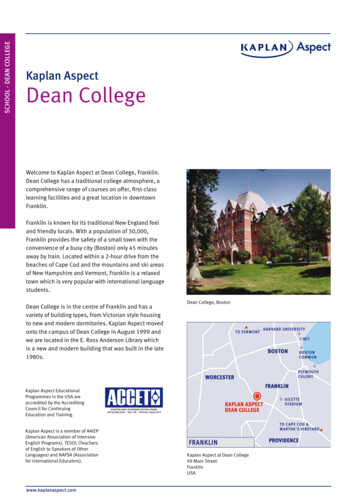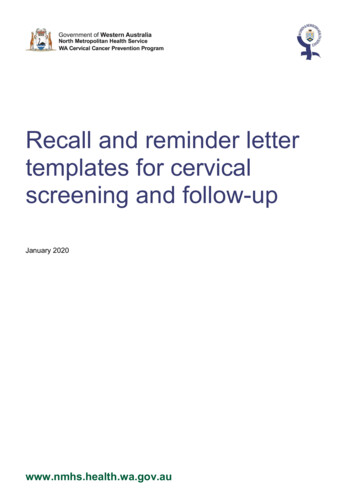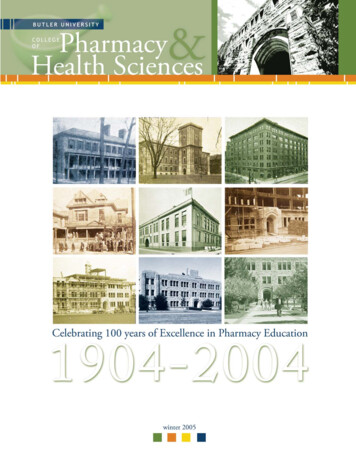
Transcription
A Letter from the DeanDear Alumni and Friends:It has been an incredible year for your College of Pharmacy and HealthSciences! Looking back, I am extremely proud of the accomplishments of ourstudents, faculty and staff. We are making tremendous progress in continuingthe excellent educational programs that have been the cornerstone of this college.We have updated facilities, renovated labs, started the PA master’s program, welcomed newfaculty and staff, approved a new laptop initiative, continued to update the curriculum to reflectnew accreditation standards, written several grants and opened the new Health EducationCenter. We also celebrated the receipt of the first endowed deanship at Butler with the investiture of the Edward and Margaret Rowe Chair for the Dean of the College of Pharmacy andHealth Sciences in April. 2004 was a very busy, but highly successful year for your COPHS!Another highlight of the year was the celebration of our Centennial Anniversary. The theme of thiscelebration was “Honoring Tradition, Pioneering Change.” In this newsletter, you will see the many examples of thewonderful work that is being done to honor tradition and to pioneer change at Butler.Honoring TraditionThe college kicked off Homecoming 2004 with its traditional open house, continuing education seminar andBeer ’n Brats luncheon. As always, it was wonderful to catch up with our extremely supportive alumni.Saturday evening we celebrated our Centennial Gala in grand style! More than 170 people attended the black tieoptional gala at the Sheraton, which was aglow with lighted trees and beautiful decorations. Special thanks to BobMyers ’68, who was our emcee for the evening and did a fantastic job of keeping the celebration light and on track.The highlight of the evening was the recognition of the first 26 Distinguished Alumni for the college. You will see aspecial story and pictures of the alumni inside. If you know any of these individuals, please send them a congratulatory note! As you know, this is the first time we have recognized the excellent contributions of our alumni. Pleasecheck the news section in this newsletter if you would like to nominate someone for this year’s DistinguishedAlumni Recognition. The awards will be given at Homecoming 2005.Another highlight of the evening was when Dr. LeRoy Salerni, professor of medicinal chemistry, gave a movingspeech titled “Memories.” It was a wonderful way to close the evening and to reflect on what we need to do tocontinue to develop our programs at Butler. Each participant was provided with a copy of the history of the collegeand a commemorative paperweight. If you would like to receive either of these mementos, drop me a line or e-mail.Pioneering ChangeOur first 100 years were quite impressive, but now it’s time to identify an exciting future for our next 100 years.A few examples of how we will pioneer change in 2005 include:Computer-assisted learning — commencing this fall all entering professional-level physician assistant andpharmacy students will receive a laptop computer. The faculty will enhance their lectures and learning activitiesusing computers.Health Education Programs — We continue to develop programs in the Health Education Center, includingthe Healthy Horizons Program for Butler University faculty and staff and the My First Patient Programfor students.Grants — in 2004 we wrote a record number of grants. We will continue to write grants to fund new initiatives in the college.Research labs — We are renovating our research labs. This year we will continue to purchase new equipmentand identify new research and contract activities. By the end of this year, we will have invested over 250,000in new laboratory equipment.Newsletter format — even our newsletter is changing for the next 100 years. I hope you enjoy this newformat.You probably have recognized that this Newsletter is coming a little late. In November, I became critically illfollowing routine surgery. I spent a month in ICU and only now am I able to return to work on a limited basis.I want to thank all of you who sent greetings, flowers and said many prayers for my recovery. They certainly madea very dark time much more tolerable for me and my family. Thanks again!Warm Regards,
A Centennial AnniversaryButler University College of Pharmacydaniel fentonIn 2004, the Butler University College of Pharmacy and Health Sciences met its centennial anniversary withthe same humble fortitude on which it was founded. Serving a perpetually changing pharmacy profession, thecollege is guided by excellence in teaching, scholarship and community service, and remains committed to itsrole in nurturing qualified health care practitioners.The present-day Butler University College of Pharmacy and Health Scienceswas founded 100 years ago as a department of the Winona Technical Institute,a trade school established on the grounds of the former U.S. Arsenal, on theeastside of Indianapolis. The Winona Institute began its fall semesteron Sept. 6, 1904, with 80 students, 12 of them students in the pharmacydepartment. Professor John A. Gertler served as director of the department.By 1910, student enrollment at the Winona Institute had peaked to more than200 students, and the pharmacy department had graduated 125 students todate. Graduation requirements at that time required the completion of two 26-week sessions for a Ph.G.,or pharmaceutical graduate degree.Growth and TransitionIn the midst of prosperity, the pharmacy department suffered a great loss with the March 1911 death of JohnA. Gertler. Further, Gertler’s successor, Albert F. Haller, a faculty member, died tragically in November 1912.The misfortune that seemed to plague the early years of the pharmacy school culminated in 1913, whenfinancial difficulties became evident. While the pharmacy department had prospered, other departments of theWinona Technical Institute had not. Rumors surfaced concerning a possible misappropriation of funds, and asdebts accumulated, litigation ensued. In 1913, the property of the Winona Technical Institute was sold to theIndianapolis Public School system to become what is now Arsenal Technical High School.An Uncertain FutureLosing its facilities could have been the end of the school, but instead it rebounded. A new charter wasprocured from the State of Indiana and in 1914 the Indianapolis Collegeof Pharmacy was born. Charged with directing the new college, Ferdinand A.Mueller was promoted to the position of dean. Another faculty member,Edward H. Niles, was named the new college’s secretary.In September 1914, the new Indianapolis College of Pharmacy opened itsdoors with 52 students enrolled. Tuition at the time was 90 a year. Roomand board in the area was estimated in an early catalogue to be approximately 4.75 per week. Faculty members were paid at the rate of 2 per lecture hour.During this period, the regular pharmacy year was lengthened from 26 to 32weeks a year.Ferdinand A. Mueller
Challenge through theWar YearsWith the onset of World War I,enrollment at the Indianapolis Collegeof Pharmacy plummeted. By the fall of1918, enrollment fell to 11 students andfinancial resources dwindled.Edward J. NilesThe confidence of Niles and Muellercarried the college through. WhenArmistice came in November 1918,Mueller and Niles anticipated increasingenrollments with the returning troops.In 1919, just as educational benefits for veteranswere enacted into law, the college purchasedproperty suitable for educational use at 522 FletcherAvenue. In 1920, veterans of World War I enteredcollege in record numbers. While the college hadbarely survived its lean enrollment numbers duringthe war — just five graduates in 1919, and six in1920 — the fall term of 1920 saw the enrollment of75 students, the largest in the college’s history todate. By 1922, freshman enrollment swelled to 100.In 1921, Dean Mueller stepped down from hisadministrative position, but remained a member ofthe faculty. Edward H. Niles was promoted to dean.Mueller died on Sept. 13, 1923.1920s and 1930sThe Indianapolis College of Pharmacy quicklyoutgrew the Fletcher Avenue facility. In 1924, theIndianapolis College of Pharmacy purchasedproperty at 800 East Market Street, the formerhome of the Indiana Veterinary College, whichhad closed in 1923.The Indianapolis College of Pharmacy foundstability in its surroundings and grew in reputationand stature, upgrading its educational standards to atrue academic and professional program. In 1925,the three-year curriculum became the minimumeducational standard for licensure. In 1927 the college became a member of the American Associationof Colleges of Pharmacy and participated in the firstnationwide inspection of colleges of pharmacy.In September 1930, ICP instituted the minimum2four-year course in pharmacy, two years before itwas required as the educational standard for theremainder of the country.The Depressionand War YearsThroughout the depression, as dozens of independent colleges of pharmacy were forced to close theirdoors, the Indianapolis College of Pharmacymaintained its enrollment standards and graduatedan average of 40 students each year. By 1940 theIndianapolis College of Pharmacy had graduated1,150 students. In 1941 the college was inspectedand accredited by the American Council onPharmaceutical Education.As the United States entered World War II, theworker shortage that plagued the nation alsobefell local pharmacies. This situation presentedopportunities for female students. Although theIndianapolis College of Pharmacy had graduatedonly two women in 1939, many more womengraduated in the 1940s. In 1942, an acceleratedcourse was adopted, with three terms given annually;this program continued until 1946. By themid-1950s, there were more than 4,000 femalepharmacists in the United States.The 1940s and the 1950s were the heyday for thelocally owned pharmacy. Independent drugstorechains like Hook’s and Haag thrived in Indianapolisalong with countless neighborhood stores. Amongthe prominent names fronting the local communitypharmacies at the time — Keene’s, Stokes, Kunz,Lee Remmeter, L.E. Smallwood, Wurster, Fritz,Rossiter’s, Warrick’s, Dorn’s, Lyon’s, Demree, Rural,Teeter, Thrasher, Freije’s, Iverson’s, Michel, Pantzer’s,Clifton, Lobraico, McSoley’s, Wenzel, Grant’s,Brown’s and scores of others.
A New Pharmacy SchoolIn 1945 the Indianapolis College of Pharmacyembarked on a new era. By merger, the ICP becamethe Butler University College of Pharmacy. Almostimmediately, a fund-raising campaign was initiatedto build and equip a modern pharmacy educationfacility on the campus of Butler University.Groundbreaking for the facility came on Oct. 18,1949, with construction completed in 1951. Thebuilding was fully occupied when students returnedfor classes for the fall term in 1951.Edward H. Niles announced his retirement after theend of the semester in 1952. Working only one yearin the building he helped to create, Niles ended histenure at Butler with the same humility in which hehad guided the college since 1921.Demand for Pharmacists,Demands of CurriculumDifficult as it was to identify anappropriate successor to Dean Niles,Butler University made a fortunate findin Karl L. Kaufman, who had come toButler University in 1949. Dr. Kaufmanwould serve the college for a quartercentury of growth, until his retirementin 1976.Demand for pharmacists continued toescalate through the 1950s and 1960s,Dr. Karl L. Kaufmannand Dean Kaufmann worked tirelesslyto support students and fill the professional demand.In 1952, the Butler University College of Pharmacyadopted a graduate program leading to a master’s ofscience degree.The Changing Role of thePharmacist in the 1960sThe 1960s was a watershed decade impactingall aspects of American life, and the pharmacyprofession was not exempt. During this time, therole of the pharmacist in the drugstore and thehospital transitioned from a product-orientation,centering on the creation of pharmacy products, toa patient-focused role dedicated to dispensing safeand effective drugs and counseling consumers onproper use.Research and development in pharmacy and drugtherapy was beginning its golden age. Prescriptiondrugs designed to treat a wide variety of ailmentswere being manufactured at an increasing rate, theresult of targeted drug design that emerged fromdecades of research into drug mechanisms and thenature of drug-cell interactions.The rise in popularity of mass-produced, tradename products spelled the end of a central functionwith which pharmacy was closely identified —compounding. Compared to the 1930s, whencompounded medicines accounted for 75 percentof prescriptions, by 1962 only 3-4 percent ofprescriptions were compounded by pharmacists,and by 1973 one percent or less were compounded.In order to educate pharmacists in a mannerconsistent with these new roles, the pharmacycurriculum was expanded to five years with theentering class of 1960. Clinical rotations wereestablished in the 1970s, requiring that studentswork in a hospital and community pharmacy settingunder the direction of a pharmacist-preceptor.After nearly a quarter century of service to thecollege and the profession, Dean Kaufman retiredin 1976. Kaufman died on Nov. 1, 1995 at the ageof 84. Following Dr. Kaufman’s retirement, Dr. DaleW. Doerr assumed the deanship in 1976, servingthe university through 1988. Doerr was a nationaland state leader in pharmacy education. The authorof more than 30 scientific papers, he also inventedexternal pill coating for medicinal tablets, holdingthe first two U.S. patents ever issued for thatprocess.Technology and TransitionsAt the height of the computer age atButler came Robert Sandmann in1988. Dr. Sandmann served as deanthrough the 1990s, concurrentlyadvancing educational standardsfor students and professionalopportunities for faculty.In 1988, the college of pharmacyestablished a tracking and a re-entrydoctor of pharmacy program, and inDr. Robert Sandmann1996 began a six-year, entry-leveldoctor of pharmacy program as the only program3
for pharmacy licensure. In 1996, the college alsoestablished a physician assistant program andofficially became the College of Pharmacy andHealth Sciences. Dr. Sandmann served as dean ofthe college for 11 years, resigning in 1999 to returnto teaching. Dr. Bruce Clayton served as interimdean until 2000.In the late 1990s, the college underwent its mostsignificant renovation to date, as a result of fundingfrom key donors such as the Lilly Foundation of EliLilly and Company and the Denis and CarolynRibordy family, owner of Ribordy Drug Stores andgraduates of the College of Pharmacy.The Reinvention ofthe College in theNew MilleniumWith the new millennium camesweeping change at the ButlerUniversity College of Pharmacyand Health Sciences. A new ageof progress came with the hiringof Dr. Patricia Chase as dean inJuly 2000. Chase embarked on anenergized plan of action to buildnew programs and consequentlynurture the college to a nationalreputation.Key to Chase’s vision wasthe expansion of the college’sDr. Patricia Chaseacademic portfolio, growing andbalancing four areas key to the college’s long-termsuccess — education, service, research anddevelopment. Toward enhanced educational quality,key developments included a coordinating StudentServices Office, design of a Pharm.D./MBAprogram, establishment of a comprehensive DrugInformation Center, a wireless technology andlaptop computer initiative, and a Health EducationCenter.The College of Pharmacy and Health Sciencessignificantly raised its national profile in 2004 withthe acquisition of two NIH (National Institute ofHealth) grants. The NIH grants came with the4hiring of Drs. Sudip and Nandita Das, specialists inoncology research.The college received another distinction in 2004 inthe investiture of Dr. Chase as the Edward J. andMargaret F. Rowe Chair for the Dean of the Collegeof Pharmacy and Health Sciences. This chair wasone of only three endowed pharmacy dean chairs inthe country. Dr. Ed Rowe was a faculty member inthe college from 1941 until 1982. He and his wifeMargaret were lifelong educators.The Future of thePharmacy ProfessionThe pharmacy profession faces major challenges forthe future. Key among these challenges is the needto meet the demand for the services of pharmacists,which continues to outpace supply. In 2004, it isexpected that 220,000 pharmacists will handle inexcess of four billion prescriptions; a deficit of170,000 is anticipated by 2020.Today, the Butler University College of Pharmacyand Health Sciences transitions a 100-year legacy ofacademic excellence into a second century of service.The theme of its centennial celebration, “HonoringTradition, Pioneering Change,” is appropriatelychosen. For in the eyes of Dean Chase, the proudlegacy of the college has prepared it well for thechanges on the horizon. To Dr. Chase, the future isin the asking. “What is the legacy that Butler willleave the profession? If we can answer that question,then we can most assuredly build our future.”
The College of Pharmacy and Health Sciences celebrated 100 years of excellencein pharmacy education with a variety of events during Homecoming 2004.This year’s Continuing Education Homecoming program was titled “Pioneering Change inHealth Care.” Dr. Peter Nalin from Indiana University School of Medicine spoke on health carechanges and Michael Cohen, president of the Institute of Safe Medication Practices, discussedhow changes affect patient safety.Following the program, alumni enjoyed the annual Beer ’n Brats lunch before heading tothe Homecoming game. Butler’s football team delighted the crowd with a win.That evening, alumni joined faculty and staff of the college for the Centennial Gala. Dr.LeRoy Salerni was the keynote speaker. His speech, “Memories,” delighted the audience withrecollections from his 30-plus years at Butler. A highlight of the evening was the installation ofthe inaugural class of Distinguished Alumni. The college honored 26 graduates from 1925-1992.Congratulations to our distinguished alumni! Look for more photos in the back of this newsletter!Inaugural Class of Distinguished AlumniFrank Lobraico ’25Winton Jones, Sr. ’24Sam Moxley, Jr. ’34Charles Cummins ’40Adele Lobraico Lowe ’41Denis Ribordy ’52LeRoy Rhea ’51Joe McSoley ’53Joe Allegretti ’59Terry Hageboeck ’57Russell Mesalam ’61Ted Roche ’61J. Douglas Reeves ’63Charles Fleming ’64Judy Ingala ’65Stan Crooke ’66Mary Ann Wagner ’68Bob Myers ’68Larry Trissel ’69Rich Powis ’74Donna Wall ’78Beth Morris ’78Jim Hussey ’82Gary Butkus ’88Craig Davenport ’91Brad Plunkett ’92Top left to right: The McSoley family; Pat Murphy, BOV chair speaks; Bob Meyers ’68, emcee for the evening, with Dean Chase.Bottom left to right: Winton and Sandra Jones; Pharmacy and PA faculty enjoy the evening; the Rhea family celebrates LeRoy’s award5
College NewsThe 2004 Interview EXPO was held Friday, Nov. 12, atthe Ritz Charles. There were 38 companies in attendanceto meet and interview our May 2005 graduates.Companies represented post-graduate opportunities ingovernment, hospital, retail, independent community andagency settings. Employers attended from across theregion and nationally — Indiana, Kentucky, Ohio,Illinois, Michigan, West Virginia and Georgia. Many ofthe companies also participated in special, on-campusevents for non-graduating students. These events permitstudents to become familiar with the numerous opportunities available to pharmacy students both during theirstudies and upon graduation.The COPHS annual faculty development retreat andkick-off for the COPHS computer-enhanced learninginitiative was held Oct. 18, 2004 at Conner Prairie. Theretreat was led by Dr. Steven Ehrmann, an internationallyrecognized authority on the use of technology to increasestudent learning. He is the vice president of the Teaching,Learning, Technology group in Maryland, and he servesas a consultant to numerous universities on the best-practice use of technology and on ways to measure learningimprovement with technology. The central theme of theworkshop was how COPHS faculty can use technology tofacilitate more active and cooperative learning by studentsin the classroom. An interesting element of the workshopinvolved faculty participating in two-way conference calldiscussions with two national authorities on the use oftechnology in science classes: Dr. John C. Wright from6Interview EXPOLevi Hall explains his research topic toother P4 students.the University of Wisconsin-Madison (chemistry) and Dr.Robert J. Beichner, North Carolina State University(physics). If you are interested in learning more about theCOPHS retreat, visit the retreat Web site at:http://www.tltgroup.org/COPHS.htm/. COPHS hasplanned a yearlong series of programs to supportenhanced computer use by faculty in their teaching inpreparation for the deployment of laptop computers toall entering first professional year students in the fall of2005.Recognizing Dr. SalerniTo celebrate their last class with Dr. LeRoy Salerni, theP3 class had custom T-shirts made with LeRoy’s pictureon the front and his top 10 “Salerni-ism” on the back.They are:10. A chemical structure is worth a thousand words.9. I’m dressed like an Easter egg.8. I like to play the molecular superimpositiongame.7. We could all use a little Haldol in our cornflakessometimes.6. I never thought I would incur a problem withthe enantiome of the “darn” overhead projector!5. If I'm lucky, I'll be dead by then!4. Does he use ’em? Does he use ’em?He!? No I don’t use ’em!3. What HOppened?2. Do this in your spare time, of which you’llhave none.1. You don't know me.Class president Jill Weigand presented three of theT-shirts to Dr. Salerni for his family while the rest ofthe class all wore them to class to demonstrate theiraffection for Dr. Salerni.P3 students wear their Salerni T-shirts to classto surprise Dr. Salerni.The class presented Dr. Salerni with his ownshirt.
Professional PartnersASHP Midyear Student Posters 2004StudentCo-presentersPosterAshley ActonKevin TuohySurvey of prevention, treatment,and surveillance of alcohol andsubstance abuse among Indianapharmacists and pharmacy studentsBeth AllenJill Leslie,Bruce ClaytonImpact of implementing a patienteducation program for neutropenicinfection risks on a communityhospital bone marrowtransplant/hematology unitJulieAndersonKathleen HaynesDo aspirin and angiotensinconverting enzyme inhibitorstogether affect mortality in heartfailure patients?HeatherBashamMonikaMcDougalInfluence of the media on theprofession of pharmacyJenniferBerghoffJennifer QuinnEvaluation of an intensive insulininfusion protocol in an adultintensive care unitSusan CarlsonMarcia HuntJane GervasioGary ZalogaEffects of arginine supplementationon hemodynamics and outcomeRandiCarpenterBonnie BrownReinstitution of the mentoringprogram for Butler UniversityCollege of Pharmacy and HealthSciences studentsLevi HallJeanne Van TyleIdentification and comparison offactors that influence the pharmacotherapeutic outcome of highlyactive anti-retroviral therapy(HAART) treatment in HIV/AIDSdiagnosed patientsMiriam KhanJulie KoehlerComparison of cardiovascularoutcomes in patients receivingtissue-selective ACE-Inhibitorsversus Angiotensin II receptorblockersKatie LyonsMeghanBodenbergCurrent use of hormonereplacement therapyDerekMcMichaelKevin TuohyPrice comparison of treatment dosesfor unfractionated heparin versusenoxaparin based upon body weightin adultsJinny MyersDean Chase saluted the Professional Partners at thecollege’s Centennial Gala Oct. 2. For information on howyour company can become a Professional Partner, contactLori Norris, director of corporate relations, (317) 9409883 or lnorris@butler.edu.Kris KeplarAmy FriendTamara EvansJohn CurtisAdherence of schizophrenic patientson atypical antipsychotics and/orhaloperidol in regards to primarycare physician appointments andutilization of the health care systemfor non-psychiatric problemsScottPapineauBruce HancockEvaluation and development ofPharm.D. rotation evaluation formsEmily PearseKris KeplarJohn CurtisEvaluation of the efficacy ofgabapentin for peripheralneuropathy at a VAMCASHP MidyearDavidRomerillTraci AdkinsTheresa SalazarEvaluation of lipid-lowering therapyinitiation prior to hospital dischargeafter acute myocardial infarction atJewish HospitalJenniferSchnaibleAmy PeakAnnetteMcFarlandElizabeth HallSafe and cost effective infusionpractices for the administration ofintravenous stance patterns with use offluoroquinolones within theIndianapolis areaTina TherosKevin TuohyRetrosective review and analysis ofdeep vein thrombosis prophylaxis inone hundred patients at MethodistHospital of IndianapolisThree well-known firms with plenty of Butler alumniworking behind their pharmacy counters — CVS, Krogerand Walgreens — were a big part of Butler’s College ofPharmacy and Health Sciences’ 100th birthday this fall.Each of the companies increased its annual gift from 10,000 to 15,000 to mark the college’s centennialduring 2004–2005.CVS, Kroger and Walgreens all participate in the college’sProfessional Partners program. Professional partnershipsbetween the college and the corporate communityprovide annual support for student programs, specialevents and other initiatives. The partners, in turn, benefitfrom being associated with Butler and its nationallyrecognized pharmacy program. They receive specialopportunities to recruit professional students, attendschool events, professional meetings and scientific seminars, and are acknowledged in the college’s communications to alumni and friends.“The Professional Partners program affords us a uniqueopportunity to forge a collaborative relationship with theButler College of Pharmacy and Health Sciences,” saidKen Ramey ’70, R.Ph., pharmacy recruiter with Kroger.“We are able to cultivate professional relations with thestudents from an early stage of their pharmacy education.This is a distinct advantage for future recruitmentopportunities.”Now in its second year, the Professional Partners programis highly valued by College of Pharmacy Dean PatriciaChase. “The program is a win-win for everyoneinvolved,” Chase says. “It is nice to know that thesecompanies feel it is a priority to commit their financialresources to our vision for the future. This year, gifts fromWalgreens, Kroger and CVS mean even more with the100th anniversary of Butler’s College of Pharmacy.”The 39th American Society of Health-SystemPharmacists (ASHP) Midyear Clinical Meeting andExhibits was Dec. 5-9, 2004. It was another great successfor Butler University faculty and students. Six full-timefaculty and over 20 students attended the meeting.Eighteen students presented posters and Butler Universitywas one of the best represented universities at the studentsession. The College of Pharmacy and Health Scienceshosted a reception for all alumni, faculty, staff and students who attended the meeting. Over 120 peopleattended the event in the Rosen Center in Orlando, Fla.At right is a list of the student and faculty presenters, aswell as their poster title.7
Jennifer Ash's abstract has been selected for an oralpresentation at Clinical Nutrition Week 2005. Jennifer isa pharmacy resident and began this project as a studentat Butler and was able to complete it in her pharmacypractice residency. Ash’s abstract was titled “Does theQuality of Enteral Nutrition Affect Outcomes inCritically Ill Trauma Patients?” Jane Gervasio, assistantprofessor of pharmacy practice and Jennifer’s guide andmentor for the project, said, “while many abstracts areselected for poster presentation at ASPEN, few areawarded the honor of oral presentation!” CongratulationsJennifer and Jane!Centennial ScholarshipAs part of our Centennial Celebration we haveestablished a centennial scholarship, which we hope toendow through alumni contributions. We need 25,000to endow the scholarship and we currently have raised 20,855. We would like to invite you to participate inthis centennial endeavor. If you would like informationon this project, please e-mail Margy Nebesio atmnebesio@butler.edu or call 1-800-368-6852, ext. 9712.A gift card for the Centennial Scholarship has beenincluded in this newsletter.Distinguished Alumni nominationsDo you know a COPHS alumnus who has made significant contributions to their field, community or ButlerUniversity? Nominate them for a COPHS DistinguishedAlumni award! Please send your nomination to DeanChase, Butler University College of Pharmacy and HealthSciences, 4600 Sunset Ave., Indianapolis, IN 46208.Awards will be presented during Homecoming 2005.PA Program GrowthThe PA program is growing and so is its classroom.For the last few years the PA program has delivered themajority of its lectures in a standard-sized classroom ofthe college. With the record number of students admittedin the fall of 2004 (45 in all) the old facilities were nolonger adequate. As a result, the college “fused” twoclassrooms together and outfitted the new “mega-room”with dedicated, state-of-the-art AV equipment. This newroom will tide us over for the time being, but with thestart of the master’s of physician assistant studies in fall2005, even more space will be needed. The number ofapplications has increased dramatically — a real tribute tothe excellent work of the PA faculty and staff.Board of VisitorsNew Members:Patrick J. Cashen, owner of Doctors ParkPharmacy, Columbus, Ind.William A. McGinnis, President and CEO AceraBiosciences, Inc., St. Paul, Minn.Teresa "Terri" A. (Lyons) Pascarelli, President ofthe Senior Executive Team of IntegrityPharmaceutical Corp., Fishers, Ind.David T. Wong, Adjunct Professor, Neurobiology,Department of Psychiatry, Indiana UniversitySchool of Medicine, IndianapolisPA students in their new classroom.Back Row: David Wong, Winton D. Jones, Jr.,Steve Dryden, Gary Butkus, Susan Malecha, PatMurphy, Pat CashenMiddle Row: Beth Morris
Tuition at the time was 90 a year. Room and board in the area was estimated in an early catalogue to be approximately 4.75 per week. Faculty members were paid at the rate of 2 per lecture hour. . In 1952, the Butler University College of Pharmacy adopted a graduate program leading to a master's of science degree. The Changing Role of the


